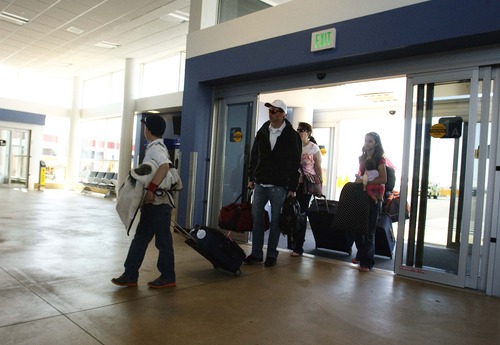This is an archived article that was published on sltrib.com in 2014, and information in the article may be outdated. It is provided only for personal research purposes and may not be reprinted.
New TRAX trains are showing they can peacefully coexist with taxis and airport parking as they all compete for travelers at Salt Lake City International Airport.
TRAX — which began running to the airport in April 2013 — appears to be attracting more riders than projected in its first year-plus of operation, according to the Utah Transit Authority.
At the same time, the airport reports that its parking revenue has increased despite the extra competition — although overall parking is down slightly. And taxi companies say they have not seen any drop in their airport business.
Barbara Gann, spokeswoman for the airport, has a guess about why they all seem to be doing fine: More local passengers have been using the airport since the TRAX line opened, so the trains, the taxis and the parking lots have had extra business to split.
"From April 2013 to March 2014, local enplaned passengers increased by 136,326," or up 2.4 percent, she said.
UTA projected in early environmental documents that the airport TRAX extension would have 4,500 average daily boardings at its opening.
"Average weekday boardings are up to 5,000 to 6,000" this year on average since the line opened, or more than the predictions for the line at opening, said UTA spokesman Remi Barron.
He said the agency does not normally track how many passengers use one segment of a TRAX line once an extension is opened, but noted the estimates come from comparing ridership on the entire green line before and after the airport service was added.
Michael Allegra, UTA's president, CEO and general manager, said he's found in conversations that the airport extension has encouraged many people who never or rarely rode TRAX previously to give it a try.
"I'm amazed," he said, "at how many people tell me they rode it to the airport, and liked it — but had not ridden TRAX before."
Allegra said the main complaint he hears about that line is that TRAX does not run late enough to handle some late flights, or early enough on weekends to service the earliest flights. UTA has said it is offering the service it can afford on the line with current revenues.
Meanwhile, Gann said, airport-parking revenue was up $500,000 from fiscal 2013 to 2014. But use of the economy parking lot decreased by 2,000 parkers, while use of the higher-cost garage increased by 500.
The cost difference between the garage and the economy lots accounted for the increase in parking revenues even though the overall number of parkers was down a bit, she said.
It's difficult to pinpoint the impact of TRAX "since data isn't available that indicates what segment of the [TRAX] ridership are people that may have used the parking facilities," Gann said. "For instance, they may be employees or passengers that would have been dropped off by another driver in the past, etc."
Ken Olsen, president of Ute Cab, said TRAX hasn't hurt his business.
"I don't think we've seen any impact all, at least none of my drivers have complained" about competition from TRAX.
He said the type of people who want the convenience of loading luggage in a cab for a quick, direct trip between the airport terminal and a hotel or home may not want to take a longer TRAX ride that could mean some walking, fumbling with luggage, or driving to a TRAX station.
UTA has attempted to encourage more TRAX airport use by eliminating rules that had banned overnight parking at its parking lots to allow multiple-day parking now at most of them.





